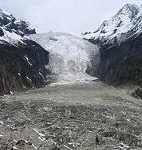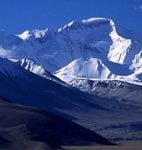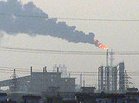In the Meili mountains in south-western China’s Yunnan province, lies the lowest of all the country’s glaciers, Mingyong. But Mingyong has been melting and receding, and the experts are blaming global warming.
On May 3, 2007, two tourists were killed in an avalanche in nearby Yubeng village. An American woman, Jane, told me that earlier that day she had seen snow sliding off overhanging cliffs and, with her mountain-rescue experience, she knew something was wrong. One of the tourists dug out of the snow had broken her back and had to be carried to help on a makeshift stretcher.
The incident gave rise to a brief flurry of news media and internet attention, but this quickly faded. The accident was blamed on global warming. But climate change is not just a matter of meteorology and geography; there also are human causes. As our ancestors might have said, man and the heavens affect each other. Or as Buddhism might say, this is the consequence of humanity’s common action.
So although the local Tibetans in Deqin, in the Deqing autonomous prefecture, have heard of global warming, they do not place blame on it. They connect the avalanche of 2007 with a range of external factors, including mountain climbing and tourism, and form their own explanation.
On January 3, 1991, a joint Chinese-Japanese mountaineering team was hit by a snow avalanche, with seventeen people losing their lives. Efforts were made to find their bodies and equipment, but harsh weather conditions forced the searchers to give up.
Seven years later, in July 1998, locals found remains of the climbers at the Mingyong glacier. The head of the village explained how they had removed every trace of the bodies. “We had to take them away, or they would pollute a sacred mountain.”
The villagers are fiercely opposed to the mountain climbing, which has gone on for years. They believe that the repeated assaults on the Kawagebo summit by the Chinese-Japanese team are to blame for the disaster. A local official explained: “If you come and climb once, it might rain, or there’ll be a flood, or storm, but there will be some effect. I grew up here, and we never used to get wolves. But now if you let the animals out, the wolves will get them.”
A village secretary spoke of his worries: “This village and the next [village] have had the worst of it. Floods, everything. The locals say that this is one of the sacred mountains of the Tibetans, and while they welcome tourism, they are opposed to mountain climbing.”
The villagers do not regard the melting glacier as an isolated event. They see it as one of a string of warnings – floods, droughts, wolves and mudslides — all demonstrating the anger of the mountain and the damage to the environment.
The avalanche and the discovery of the climbers’ bodies actually increased the number of visitors to the village, and the locals became rich by acting as tourist guides. But every time I visit, they seem more nervous as they see the glacier retreat. A tourist bureau employee said that Tibetans believe an angered mountain will retaliate by sending disasters, and that glaciers, too, are sacred. They believe that allowing the glacier to be damaged by visitors and causing it to recede has angered the mountain.
Yubeng, deep in the mountains, only became a popular tourist destination in 2003 – but just a few years later, the avalanche struck and killed two tourists. A friend, who was with Jane at the scene, told me they had seen climbers strip naked and dance on the mountain. To the Tibetans, this is sacrilege.
Geng Hong, head of the provincial land office’s geographical environment bureau, has visited the Mingyong glacier on numerous occasions. He found that in the process of building wooden walkways for tourists, large numbers of stones had been allowed to fall onto the glacier. These stones heat up in the sun and cause the glacier to melt. The visitors themselves also are a source of heat. Under these circumstances, the glacier is bound to melt.
According to the villagers, the mountain climbers and revelling tourists’ behaviour and the things they leave behind – such as their corpses and the ashes of their burnt rubbish – are the source of the mountain’s anger.
The film Glacier by Zhaxi Nima records a discussion among the villagers about the melting Mingyong glacier. They believe that when foreigners visited to collect biological specimens almost one hundred years ago, they used magic to calm the mountain – and the glacier receded. As one local asked: “So why is it melting now? Electricity, people wandering up the mountain, not protecting the forests, polluting the glacier … it’s like the glacier is ill and wasting away.”
There were other comments:
“Before when it melted, it would just be the face of the glacier; it would not actually get smaller. Now it’s both. Before 2000, lots of people came, pollution was bad and we got electricity. The three things all happening together was a disaster.”
“If people didn’t climb the mountain, leave rubbish or use electricity, the glacier would recover. If things carry on this way, it will continue to recede.”
The villagers attribute the receding of the glacier to several factors: the damage caused by foreigners, pollution of the glacier by climbers, abuse by tourists, the connection of electricity and pollution from rubbish. However, all these factors can be classified as the effects of almost a century of exploration and development by outsiders. These ideas also underscore the disparity between the villagers’ and the experts’ opinions: the experts see natural reasons, the villagers see man-made ones.
When discussing climate change, it is very easy for us – as an area, a village, a population – to shirk our own responsibility, transforming the consequences of human activity into a complicated issue of international politics, simplifying a complex cultural background into a simple “scientific issue”. People believe that political negotiations and scientific research will be adequate, and we can all carry on climbing mountains, taking holidays and throwing away our rubbish. But nature may take its revenge at any time.
The Mingyong glacier is still melting away, and the locals are still debating. They are caught up in the tourist trade, which enables to make a living, but not to live at peace. The mountain’s anger hangs over them. The villagers know that no experts or technology will ward off disaster, just humanity’s own awakening and action.
Guo Jing is a researcher with the Yunnan Academy of Social Sciences (YASS).
Homepage photo by Richard.Asia




